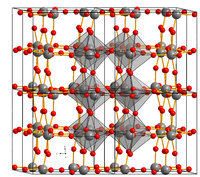
Photo from wikipedia
The photocatalytic CO2 reduction reaction is a sustainable route to the direct conversion of greenhouse gases into chemicals without additional energy consumption. Given the vast amount of greenhouse gas, numerous… Click to show full abstract
The photocatalytic CO2 reduction reaction is a sustainable route to the direct conversion of greenhouse gases into chemicals without additional energy consumption. Given the vast amount of greenhouse gas, numerous efforts have been devoted to developing inorganic photocatalysts, e.g., titanium dioxide (TiO2), due to their stability, low cost, and environmentally friendly properties. However, a more efficient TiO2 photocatalyst without noble metals is highly desirable for CO2 reduction, and it is both difficult and urgent to produce selectively valuable compounds. Here, a novel “single‐atom site at the atomic step” strategy is developed by anchoring a single tungsten (W) atom site with oxygen‐coordination at the intrinsic steps of classic TiO2 nanoparticles. The composition of active sites for CO2 reduction can be controlled by tuning the additional W5+ to form W5+–O–Ti3+ sites, resulting in both significant CO2 reduction efficiency with 60.6 μmol g−1 h−1 and selectivity for methane (CH4) over carbon monoxide (CO), which exceeds those of pristine TiO2 by more than one order of magnitude. The mechanism relies on the accurate control of the single‐atom sites at step with 22.8% coverage of surface sites and the subsequent excellent electron–hole separation along with the favorable adsorption–desorption of intermediates at the sites.
Journal Title: Advanced Materials
Year Published: 2022
Link to full text (if available)
Share on Social Media: Sign Up to like & get
recommendations!